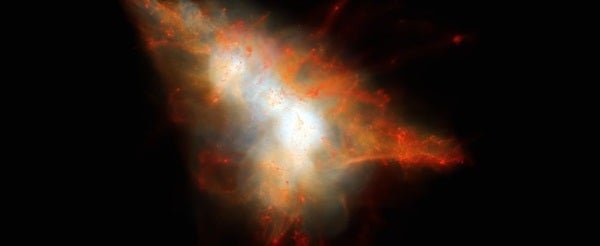A combination of observation and modelling sheds new light on how Lyman-Alpha blobs form and why they shine so brightly.
Lyman-Alpha blobs are among the rarest denizens of the distant universe. They’re giant clouds of hydrogen gas spanning hundreds of thousands of light years, named for the trademark radiation they emit. Now combined observations from several telescopes have given astrophysicists a look at what’s going on inside and what produces the characteristic radiation.
For 15 years, physicists have speculated and debated about how these luminous cosmic blobs form and what’s going on inside them. This is an important question because Lyman-Alpha blobs appear to be the cosmic nurseries where the largest galaxies in the universe are born. Mapping out where Lyman-Alpha radiation comes from, and what it’s reflecting off of to form the glowing cloud we see, could help understand that galaxy formation process.
“The really exciting thing is that the Lyman-Alpha is really telling us about what’s going on in the immediate environment around the young galaxies,” said astrophysicist Jim Geach of the University of Hertfordshire. “Basically it is an environment that is very important for our understanding of how galaxies are growing, but is very difficult to study. Nature has handed us this neat trick with the scattering of Lyman-Alpha photons to figure out what’s going on in these rare objects.”
Anatomy of the Blob
In search of answers, Geach and his colleagues looked 11.5 billion light years away, to the first Lyman-Alpha blob ever discovered, SSA22-Lyman-Alpha-Blob-1 (its friends just call it LAB01). Even among Lyman-Alpha blobs, it’s a giant at 300,000 light years wide. Thanks to a combination of observations from the Atacama Large Millimeter/Submillimeter Array (ALMA), the Very Large Telescope (VLT), Hubble, and the Keck Observatory, we’ve got the first detailed look at what’s going on in there. They published their results in The Astrophysical Journal.
At the heart of LAB01, two young galaxies are slowly colliding. They’re also busy spawning new stars at a frantic rate, about 100 times that of our own Milky Way Galaxy. The two merging galaxies resolve a long-running debate about what’s in the center of a Lyman-Alpha blob.
Since LAB01’s discovery in 2000, some astrophysicists have predicted that Lyman-Alpha blobs should have dusty, star-forming galaxies at their hearts, but the evidence was contradictory. Some observations supported the prediction, but then, according to Geach, “The confusing thing was that not all LABs showed such galaxies. The problem is that many of the early observations were not sensitive enough to detect such sources.”
In 2014, Geach and his team detected a very bright source of far-infrared radiation at the center of LAB01, but the Maxwell telescope didn’t give them enough resolution to map it in much detail. That had to wait for the team to get observation time on ALMA in 2015.
Using ALMA, along with a spectroscopic instrument called MUSE on the VLT, the researchers were able to map the location of that source in much greater detail, revealing the two bright galaxies in the midst of the Lyman-Alpha blob. Over the next few billion years, Geach says they’ll merge into a single large elliptical galaxy, which will one day rule its own massive galactic cluster.
The two merging galaxies are at the heart of a group of smaller, fainter galaxies, which seem to be in the process of forming a cluster around the larger two. Each of the large central galaxies is about 30,000 to 60,000 light years across, while the smaller “satellite” galaxies average about 3,000 to 6,000 light years. Those little galaxies are also churning out new stars, but much more slowly than their bigger sisters. However, they may be driving the explosive rate of star formation in the larger galaxies by contributing gas through accretion.
How the Blob Gets Its Glow
That data may help explain why Lyman-Alpha blobs look like, well, blobs of light. Geach and his team wanted to see if a computer model of galaxy formation could produce something that looked like what was going on inside LAB01. Their simulation turned out to basically reproduce the structure they had observed with ALMA: big central galaxies surrounded by a swarm of smaller ones.
All that active star formation in the central galaxies emits lots of UV light, and those photons bounce of the surrounding cloud of hydrogen gas, producing a diffuse glow. It’s a cosmic-scale version of what happens when the glow of a streetlight is scattered and blurred by fog. Geach says that process of diffusion explains much of LAB01’s cloud of Lyman-Alpha emissions.
The next step, according to Geach, is higher-resolution mapping of the Lyman-Alpha emissions in LAB01. “Currently our mapping of the Ly-a is limited by ground-based ‘seeing’, which blurs out detail. But an upgrade to the MUSE instrument on VLT will offer ‘adaptive optics’ to correct for this and enable us to map the Blob in far better detail,” he said. “This will give us a far better understanding of how this emission is linked to the galaxies embedded within the Lyman-Alpha blob.”










